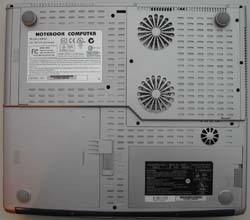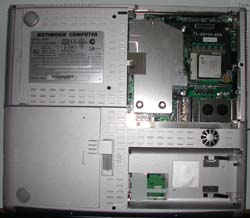Hypersonic Sonic Aviator 3.06GHz Pentium 4
by Matthew Witheiler on January 7, 2003 4:02 AM EST- Posted in
- Laptops
Construction - Build, Appearance, Size (continued)
The front of the Sonic Aviator is home to what Hypersonic calls the "Audio DJ" feature. Audio DJ allows the user to play CDs even while the unit is powered off. We have seen this feature on a handful of other notebook systems and found it to be fairly useful. Giving the system the ability to play audio CDs while powered off means that the unit does not have to be booted up to listen to music and thus can run for a long time as an audio CD player. It also means that a separate CD player need not be carried on trips, as the notebook can do the same thing for hours upon hours using the audio DJ feature. The front panel provides a power button to turn the CD player on while the unit is off, two skip buttons (forward and backwards), a status LCD that shows current track number, a play/pause button, a stop button, and volume up and down buttons. Audio DJ takes up a good deal of Sonic Aviator's front. It is a good thing that the feature has to be turned to enable audio playback as the outward location of the audio DJ buttons made them easy to press while handling the unit or carrying it around.
The audio DJ buttons also functioned under Windows for the most part. The track forward/back, play/pause, stop, and volume buttons all perform the correct function while in an audio player such as Windows Media Player. The only thing portion of audio DJ that did not function while booted was the power switch. It would have been nice if the power switch on audio DJ opened the default music player, but this was not the case.
For the most part the left side of the Hypersonic Sonic Aviator is dominated by cooling vents. As you can see, the back half of the system's left side is dedicated to cooling. This large area serves as the CPU exhaust port, as air is collected from under the system via a set of two fans, passed over the heatsink, and blown out here. One gets a hint of the extreme amount of cooling employed by the Sonic Aviator by noting the mass of metal that lies behind the plastic casing. The design of the Hypersonic Sonic Aviator suggests that some serious heat is produced in the system and our thermal tests verified this. The temperature of the air coming out of the left exhaust port got as hot as 144.5 degrees Fahrenheit (62.5 degrees Celsius), making it one of the warmest notebooks we have seen.
The left side of the system is also home to a single type II PCMCIA slot. It was a bit odd to see only a single PCMCIA slot on a system as large as the Sonic Aviator but disassembly shows that all the extra space gained by not including a second PCMCIA slot is used for cooling purposes. Since the notebooks has a number of features built-in, including firewire and USB 2.0, the single PCMCIA slot should suffice for most uses (although the lack of integrated wireless means that a number of users will find the slot quickly filled by a wireless card). Also on the left side is the system's power connection. The power port on the Sonic Aviator is a bit odd, consisting of four large pins which appear to be necessary considering the power adapter outputs a whopping 20 volts at 6.0 amps.
We have come to expect that desktop replacement systems like the Hypersonic Sonic Aviator come outfitted with a full array of ports and jacks. The Sonic Aviator met these expectations and exceeded them in some instances. The back of the system featured no less than 14 ports. From right to left these ports are: a PS/2 port for an external mouse or keyboard, a parallel port, a serial port, a TV-out port capable of supplying s-video or composite output, an ethernet jack, a modem jack, a vertical stack of two USB 2.0 ports, a horizontal row of two more USB 2.0 ports, a 4-pin unpowered IEEE 1394 (firewire) port, an audio-out jack, a headphone-out jack, a microphone-in jack, and a Kensington lock port.
The Hypersonic Sonic Aviator came with just about every port we could ask for, all located conveniently on the back of the system. The USB 2.0 and firewire support that the system offers should prove to provide a wide variety of expansion options for the notebook. We are always pleased to find USB 2.0 support on laptops as it means that the next generation peripherals will be supported without the use of a separate PCMCIA USB 2.0 controller. The same thing goes for the firewire port: although it is an unpowered 4-pin port, it still provides an interface for commonly used components.
The audio-out port on the Hypersonic Sonic Aviator is capable of supporting digital output. When enabled in BIOS, the 1/8th inch audio-out port becomes an optical audio-out port indicated by the glowing red light in the port.
Both the floppy drive and the selected optical drive are found on the right side of the Hypersonic Sonic Aviator. The system can be outfitted with an 8X DVD / 16X-10X-24X CD-R/W combo drive, a 8X-4X-24X CD-R/W drive (for $90 less), a 8X DVD-ROM drive (for $200 less), or no drive at all (for $270 less). The floppy drive comes standard with the system. There is also an IR port located above the optical drive bay.
The most striking aspect of the Hypersonic Sonic Aviator's bottom are the three cooling fans located here. The two large fans in the back-middle of the system's bottom are two intake fans used to pass cool air over the CPU heatsink and out through the cooling vents on the system's left side. The smaller fan, located above the battery, is used to provide additional cooling to the power components of the laptop. Luckily, all three fans are thermally controlled and only spin when necessary. When all three are running the system gets fairly loud, but we found that in most cases the fans remain off or run at a reduced speed (and are thus more quiet).
There are four rubber ended feet on the system. The rear feet are slightly taller than the front ones, causing the unit to prop somewhat forward while on a table. These feet are necessary to ensure that the cooling fans are far enough off a surface to get the cool air they need to keep the system stable.
The optical drive, floppy drive, and battery are all easily removed using release levers (the optical drive does require removal of two screws). There is one large access panel on the Sonic Aviator's bottom. The panel is located above the two fan intake vents and once removed the system's fan and heatsinks are visible. Removing the fan and heatsink structure gives easy access to the system's desktop CPU.
The features that the Hypersonic Sonic Aviator offer suggest that the unit is nothing short of a desktop replacement and the size and weight of the notebook confirm this. The powerful system measures 1.7" x 13.0" x 11.4" and weighs a heavy 9.6 pounds. Size wise the system is not all that much bigger than the Dell Inspiron 8200 (only larger in the depth measurement by 0.6") but weighs a good deal more than the Inspiron's 7.9 pound weight. Like other desktop replacement notebooks, the Hypersonic Sonic Aviator is not a traveler's best friend. The system is big, heavy, and cumbersome. The system is most at home on a desk, not on the road. Carrying the unit occasionally from one location to another is not all that bad, but if you plan on doing so on a regular basis you best have a good chiropractor in the area.
















0 Comments
View All Comments